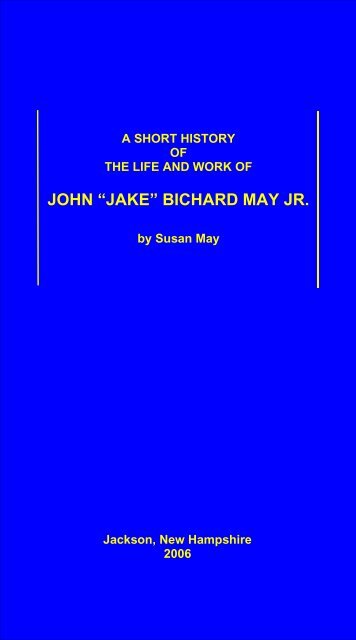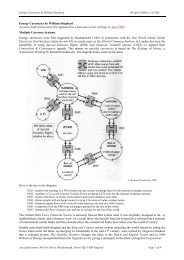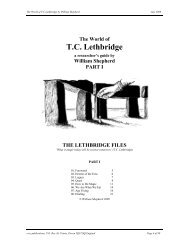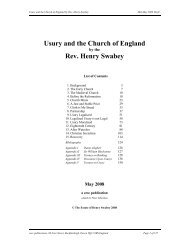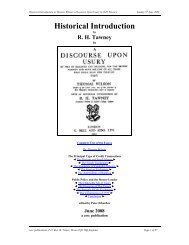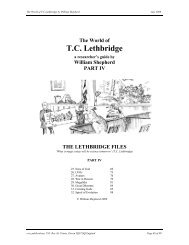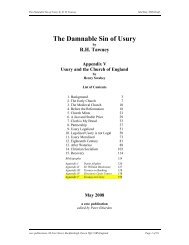You also want an ePaper? Increase the reach of your titles
YUMPU automatically turns print PDFs into web optimized ePapers that Google loves.
A SHORT HISTORY<br />
OF<br />
THE LIFE AND WORK OF<br />
<strong>JOHN</strong> “<strong>JAKE</strong>” <strong>BICHARD</strong> <strong>MAY</strong> <strong>JR</strong>.<br />
by Susan May<br />
Jackson, New Hampshire<br />
2006
Susan with the Chair that Jake made for her
A SHORT HISTORY<br />
OF<br />
THE LIFE AND WORK OF<br />
<strong>JOHN</strong> “<strong>JAKE</strong>” <strong>BICHARD</strong> <strong>MAY</strong> <strong>JR</strong>.<br />
by Susan May<br />
Thanks to Joel Pratt, Mack Beal and<br />
Susan Norton-Taylor May<br />
Jake was born John Bichard May, Jr. in 1908 in<br />
Duxbury, MA, the first of four sons to Dr. and Mrs.<br />
John May. His middle name, Bichard, was the family<br />
name of his great-grandmother who came from<br />
the islands of Alderney and Guernsey in the English<br />
Channel.<br />
After several moves, the May family settled in Cohasset,<br />
where Mrs. May ran a small private kindergarten,<br />
and Dr. May made his rounds by horse and<br />
buggy. Sometime in the 20’s Dr. May gave up his<br />
medical practice in favor of ornithology and in the<br />
late 20’s he succeeded Edward Howe Forbush as<br />
the state Ornithologist with the Department of Agriculture.<br />
Dr. May gave lectures to adults and to school children<br />
and he authored or edited many articles and at<br />
least three books on birds. Every summer the family<br />
moved to Little Squam Lake in Holderness, NH,<br />
where the Mays ran a girls’ camp called Winnetaska.<br />
With four sons, it seemed a better idea to have<br />
a boys’ camp so they made the switch sometime<br />
after Dick’s birth in 1915.<br />
People have asked me how the May brothers found<br />
their way to Jackson. I suppose it was during those<br />
summers of canoe trips and hiking overnights that<br />
1
they found the White Mountains and then later<br />
became curious about this new sport of skiing. With<br />
a teacher and a naturalist for parents, it’s easy to<br />
see how the brothers developed a fondness for the<br />
outdoors, for trees and ultimately for making things<br />
of wood. Each one, in fact, built at least parts of his<br />
own house.<br />
In 1926, Jake and his childhood friend, Elmer “Pop”<br />
Pratt entered the Boston Architectural Club when it<br />
was still a free school. They shared a series of<br />
cheap apartments all over Beacon Hill, including<br />
one in Champney Place and they worked as apprentice<br />
draftsmen to pay the bills. Neither finished<br />
the 7 year program at the school. Around 1934<br />
Jake worked with the Civilian Conservation Corps<br />
on Mt. Greylock in Pittsfield, Massachusetts.<br />
He had a blueberry business on Cape Cod for a<br />
while and even tried distributing shellfish in Western<br />
Massachusetts till one day when his truck broke<br />
down, the ice melted and the fish spoiled. This was<br />
a man with enormous talent but little business<br />
2
sense. During these years, Jake would frequently<br />
show up at the Pratt house with a piece of furniture<br />
to show to Pop. Pop knew that this meant Jake<br />
needed money so he’d buy the piece for whatever<br />
low price Jake named plus a good meal. The Pratts<br />
ended up with about 15 pieces either commissioned<br />
or bought in this way.<br />
As for people skills, it’s well known that Jake didn’t<br />
possess those either, although my Mother says he<br />
charmed her fellow waitresses at Whitneys’ in the<br />
early 40’s and certainly he made an impression<br />
wherever he went. And Pop Pratt’s son Joel liked<br />
his visits. He says Jake was “big and hearty and<br />
loved children”.<br />
In 1941 Jake married Thalia Keith, daughter of the<br />
mayor of Brockton and sister of state representative<br />
Hastings Keith. By November, they were living in<br />
Jackson and their first child, Gail, was born. They<br />
lived at Overlook in the cottage that Nicholas Howe<br />
now occupies, and Jake used Stanley Howe’s workshop,<br />
which is the red section of the main Overlook<br />
house, now Ben Greene’s home. On the inside<br />
doorway trim there are still scratch marks visible<br />
every three inches. These marks were for ski measurements<br />
as Jake was in business customizing skis.<br />
Here’s how Mack Beal described them to me:<br />
Jake bought hickory blanks from the Paris Ski Company<br />
of Paris, ME. These blanks were about 1” thick<br />
by 3” wide with one end already steamed into a<br />
curve for the tip.<br />
Jake would use various hand tools, including a draw<br />
shave and planes to create a raised ridge along the<br />
center of the ski flattening out at the binding area<br />
and as the tip or shovel started to curve upwards.<br />
He rounded all the top edges, stained the hickory to<br />
3
a dark brown, then scraped off the stain along all the<br />
edges to create a lighter colored band around the<br />
whole ski. This made a very attractive finished ski.<br />
He would then use a “burning pencil” to inscribe<br />
“Jake May Special” onto each ski. For the ski bottoms,<br />
Jake first put white celluloid on the edges of<br />
the shovel to protect it from wearing out. Then, he<br />
would install the steel edges. The early edges were<br />
simply thin narrow rectangles of steel about 8” long<br />
that screwed into the rabbetted edges of the ski.<br />
Later, edges were modified so that the ends interlocked<br />
and later, edges angled from top to bottom<br />
to provide a better fit and smoother ride. Both Dick<br />
May and Francis Sargent (later governor of Massachusetts)<br />
had their “Jake May” skis with them at<br />
Camp Hale.<br />
By the time World War II started, Mrs. May had<br />
closed her school and started working at Derby<br />
Academy in Hingham. At this time, Jake and Thalia<br />
went to live in Cohasset and Jake adapted the<br />
schoolhouse to be their home, using one of the<br />
classrooms for his shop.<br />
This schoolhouse, incidentally, was a Hodgdon prefab<br />
dating from World War I. The next two kids,<br />
Keith and Fitz were born in Brockton. Jake’s acute<br />
asthma kept him from active duty and he spent<br />
some of the war making wood gun stocks in South<br />
Boston.<br />
He was also in the Cohasset Company of the Massachusetts<br />
State Guard serving as a cook when<br />
they were on maneuvers. His friend Pop Pratt was<br />
second in command of the unit. By 1948, the family<br />
of five was back in Jackson.<br />
4
They bought a small cape house beyond what is<br />
now Black Mountain Ski Area. Jake added a second<br />
floor to the house and worked in the old schoolhouse<br />
which later became the base lodge of the ski<br />
area.<br />
After the schoolhouse he had a workshop in a<br />
building behind what is now the bar of the Wildcat<br />
Tavern. Brothers Bill and Dick joined Jake there.<br />
Bill, his wife Eleanor and daughter Wendy lived both<br />
in Stanley Howe’s house and in the Shapleigh<br />
house.<br />
Later, Jake would move his workshop into the shed<br />
next to his house and their living room doubled as<br />
showroom for his work.<br />
Jake kept a barrel of cider in his basement for which<br />
he was apparently well-known. Many people have<br />
mentioned this to me. Last year Roger Burnell told<br />
me he did a lot of surveying for Jake and at the end<br />
of a day; Jake would invite him down cellar for a<br />
glass or two.<br />
Cynthia Pratt Pensinger told me she and a friend<br />
were visiting, they were asked to go get some cider<br />
for another guest, then they helped themselves to a<br />
few and later went skiing. She says it’s the only<br />
time she ever skied uphill.<br />
Jake and Thalia had a grandfather clock that was<br />
too tall to fit in the living room so Jake scooped a<br />
piece out of the ceiling to accommodate it. It’s still<br />
there.<br />
The house is of traditional design except for the<br />
dining room, which extends beyond the rectangular<br />
footprint. That still has floor to ceiling windows that<br />
Jake put in looking out over the brook.<br />
5
In this room was one of Jake’s free form coffee<br />
tables made from a huge tree stump and roots,<br />
smoothed and varnished and with a large glass top.<br />
Since I was close to floor level at that time, I liked<br />
looking for the tiny toys that the kids had placed in<br />
the crooks of the tree.<br />
During these years in Jackson, Jake developed his<br />
art and incidentally owned one of the first Volkswagen<br />
microbuses in this country - a red and black one<br />
with the sightseeing windows along the edge of the<br />
roof. I think for a short time he was running a taxi<br />
service with the bus. The family traveled to Florida<br />
in the winters so Jake could try to find some relief<br />
from the asthma. At this time he’d make a side trip<br />
to Cuba to buy wood to be shipped to New Hampshire.<br />
In his shop, Jake was making door knobs to sell to<br />
his friend Pop’s firm, WC Vaughan Company of<br />
Boston. Pop would design the knobs and send the<br />
wood to Jake. For someone as creative as Jake,<br />
manufacturing the knobs was tedious.<br />
6
In addition to having Mack Beal turn about 10,000<br />
knobs, he later subcontracted the turning out to a<br />
Mr. Hall (I’d be interested to know who this Mr. Hall<br />
was) without telling Pop Pratt. Mr. Hall charged<br />
very little to do this and Jake could pocket some of<br />
the money. After some time, Pop found out and<br />
took his business directly to Mr. Hall. This was the<br />
first strain on their friendship.<br />
Jake also designed and made lots of different pepper<br />
mills (which because they have carbon steel<br />
innards, still work), and, moved from furniture to<br />
exquisite bowls. Mack Beal also turned some of the<br />
pepper mills, and one day, while cutting up some<br />
tropical wood on a band saw cut open a nest of<br />
small coral snakes. Mack quickly tossed the pieces<br />
of wood out the door.<br />
Jake also was responsible for the little sap buckets<br />
that were given to winners of the annual Sap Run<br />
Race at Black. He made small chairs for family<br />
children - I had one, but Daddy let someone borrow<br />
it and it was never returned.<br />
About five years ago I found pieces for one in the<br />
cellar which I sent to Jake’s son John to assemble.<br />
It’s possible the one that Warren bought for the<br />
Historical Society is indeed my old missing chair<br />
with rockers added.<br />
Around 1946, a consortium consisting of Jake, Dick,<br />
and Bill May, Rink Earle and Bob Cann and others<br />
bought a rope tow from Woody Stanton of Bartlett.<br />
They made a few improvements and set it up on the<br />
Davis Pasture opposite Jake’s house. When Black<br />
Mountain Ski Area opened, the rope tow got sold<br />
again, this time to Iron Mountain House where it<br />
went up the slope below Duck’s Head to the left of<br />
the Red Fox parking lot. The last Dick knew, this<br />
7
ope tow was somewhere in the Sanford, Maine<br />
area in the 1970’s.<br />
Jake and Thalia’s fourth child, Carolyn was born in<br />
1948, and Sam in 1952, and not too long after<br />
Sam’s birth the Mays left Jackson for Rockport, ME.<br />
Jake left there soon afterwards. After this he lived<br />
in New York City, New Hope, PA and in Portsmouth,<br />
NH. In about 1960, he showed up at our house in<br />
his Citroën station wagon (do you see a family trait<br />
here?) with his new wife, Susan Norton-Taylor, a<br />
potter.<br />
From this point I will inject word for word some<br />
comments that she wrote:<br />
During several summers while he was living in<br />
Rockport he joined the faculty of Haystack Mt. Craft<br />
School where he taught wood turning and furniture<br />
design.<br />
Winters were spent in Sarasota, Florida, first with<br />
the entire family and later with only a couple of his<br />
children since he and Thalia had decided to part<br />
company and some of the children stayed with her<br />
in Maine.<br />
After their divorce, Jake married Susan Norton-Taylor,<br />
whom he had met at Haystack . They moved to<br />
Portsmouth, NH and purchased a four story brick<br />
building on the Piscataqua River which included a<br />
large dock and a view of the Memorial Bridge (a<br />
draw bridge).<br />
On more than one occasion they would see a vessel<br />
trying to get the bridge open. Apparently the bridge<br />
tender was a sound sleeper so they would telephone<br />
him to wake him up. A navy ship got stalled<br />
there one day. It had to lower the anchor so it<br />
wouldn’t get swept into the bridge, the anchor got<br />
8
hooked onto a cable running across the bottom of<br />
the river– it was a scene and a half!<br />
Sue was a potter so they put a ceramic studio in the<br />
basement, a showroom on the first floor (at street<br />
level), Jake’s woodworking shop on the second and<br />
mostly nothing on the third. That’s where a family of<br />
bats hibernated. Every time Sue fired her large kiln,<br />
the bats would think warm weather had come and<br />
would fly downstairs looking for insects.<br />
Jake exhibited his furniture, lamps, bowls and pepper<br />
mills in the showroom, also Sue’s pottery, some<br />
weavings, silver and pewter, glass, etc. During their<br />
years there, their first child was born, named Scott<br />
Duncan. Jake designed and he and Sue built, a<br />
house for a client in Kittery, Maine, and they started<br />
a ceramic free-standing fireplace business. The<br />
“firepots” were hand made, initially of fireclay, then<br />
fired in Sue’s kiln.<br />
After several years there they decided to set up a<br />
shop further south and moved to Little Compton, R.I<br />
Jake continued making firepots, now with silicon<br />
carbide, a more durable material, and Sue continued<br />
her pottery operation. However, demand was<br />
increasing for the fireplaces and Jake finally decided<br />
to farm out the manufacture to a crucible<br />
company in Taunton, Ma.<br />
This was successful for a while but eventually<br />
turned sour because the owner was covertly trying<br />
to take over the manufacture and sales, leaving<br />
nothing for Jake and Sue.<br />
Jake trusted everyone and was really never tuned<br />
into the modern world of “gimme” and greed. The<br />
company even sued them for some trumped up<br />
cause and they had to hire an attorney and counter<br />
9
sue. They won but it was costly and time consuming<br />
and not the way either Jake or Sue wanted to<br />
spend their time.<br />
Meanwhile, Jake had built a wood sailing vessel<br />
which they launched at Westport Harbor and enjoyed<br />
many hours of delightful sailing.<br />
Also, they had three more children, Joan, Nat, and<br />
John, keeping Sue very busy, while also running the<br />
office side of the firepot business.<br />
Jake’s dream for years had been to build a large<br />
enough boat to live on, have a workshop, and travel<br />
to the islands for tropical woods for his turnings, etc.<br />
He decided to go ahead with that plan and after<br />
consulting several naval architects, decided on a<br />
55’ steel Nova Scotian, double ended design with a<br />
junk rig.<br />
He found a yard near Fall River, Ma. to build it and<br />
work began in the fall of 1967. Then tragically on<br />
April 19, 1968, their first born son, Duncan, was hit<br />
by a car while riding his bike and died instantly. He<br />
was seven and a half, exceedingly bright, a gifted,<br />
charming little boy. Neither Jake or Sue ever got<br />
over it. But life goes on and there were those left<br />
behind who still needed nurturing and love.<br />
In July 1969 Sue gave birth to Ned, their fifth child.<br />
In the meantime, work on the hull of the new boat<br />
was completed so Jake had it moved to Little Compton<br />
and parked in the driveway so he could outfit<br />
the interior, including foam insulation, cabinets,<br />
bunks, etc. They had decided to sell the firepot<br />
business and move on to the boat so moved into<br />
Fall River while it was being finished.<br />
The boat was launched in 1970 and Jake and a<br />
crew sailed it to Oxford, Maryland where Sue and<br />
10
the children had gone earlier to stay with Sue’s<br />
parents and wait for their new home to arrive.<br />
They all moved on and in the fall of 1971, left Oxford<br />
for parts south.<br />
Sue home schooled all the children as they traveled.<br />
They tied up at a marina in Florida for a while where<br />
Sue put the children in school.<br />
They sailed around the Caribbean Islands, back to<br />
Florida, over to the Gulf side, etc., back and forth to<br />
Westport, Ma. Finally, on one trip when the boat<br />
had been hauled out in Cambridge, Md. Jake had a<br />
car accident and was laid up for some months.<br />
After he recovered, he moved back on Aurora and<br />
sailed it up to Portsmouth, NH where it suffered<br />
some damage from a hurricane and had to be<br />
hauled out again. Regrettably, he never got it back<br />
in the water.<br />
Meanwhile, he had gotten involved in the Strawberrie<br />
Banke village project and was hired on as the<br />
resident woodworker. He had a small shop and<br />
started making furniture and doing wood turnings.<br />
11
The children had stayed in Maryland to go to school<br />
but spent their summers with Jake.<br />
Now back to my part of this story:<br />
One winter in the mid 80’s Jake had some spare<br />
time and I needed some work done so he spent two<br />
months at my house in Boston rebuilding, by hand,<br />
my stair railings and newel posts which had been<br />
burned, and making moldings for door frames and<br />
trim that had been taken out in a fit of 60’s/70’s<br />
“modernization”.<br />
In spite of leaving two wives (he said they left him)<br />
he talked constantly about his boys - there being a<br />
pretty obvious inability to relate well to females.<br />
He used to tell us about his “Sunday stew”, a meal<br />
made from the previous weeks’ leftovers. This<br />
never worked for me.<br />
My son still quotes Jake asking for seconds by<br />
saying “Does anyone want this more than I do?”<br />
I was running a small Bed & Breakfast then, and<br />
Jake charmed my guests with his stories about his<br />
boat and his children.<br />
In 1986, Jake came to Jackson for the last time, to<br />
be honored as one of the “Legends of Jackson<br />
Skiing”.<br />
And more comments from Sue:<br />
After graduating from Bates College in 1988, John,<br />
Sue and Jake’s second son , joined Jake at Strawbery<br />
Banke.<br />
In addition, his son Nat is a talented architect and<br />
builder, Joan is an artist, Ned has done glass blowing<br />
(though his main talent as a financial wizard was<br />
probably not inherited from Jake!), Sam and Keith<br />
12
are builders, masons, (& expert businessmen), Carolyn<br />
is an interior designer and Fitz is a ski instructor<br />
so a piece of Jake lives on in each one.<br />
Interestingly, John is the only one of Jake’s ten<br />
children who was named after him and he is the one<br />
who followed in his footsteps as far as being an<br />
extremely talented and creative wood turner and<br />
furniture maker.<br />
Jake taught him well.<br />
13
Jake’s Farewell<br />
In March of 1989 at the age of 81 while<br />
doing what he loved, turning a bowl, Jake<br />
had a fatal heart attack.<br />
He was a Renaissance man, an artist,<br />
designer, architect, inventor, sailor, chef,<br />
builder (houses and boats and anything<br />
else) woodworker, electrician, plumber,<br />
outdoorsman, skier, In essence, he could<br />
do just about anything.<br />
He left a considerable body of work and<br />
was included in many exhibitions and galleries<br />
throughout his working life.<br />
As recently as 2002, two of his pieces were<br />
in an exhibition at the Smithsonian’s Renwick<br />
Gallery, and also in the book Wood<br />
Turning in North America Since 1930.<br />
I believe we have a copy of that book here<br />
tonight which will then be donated to the<br />
Jackson Library.<br />
14


